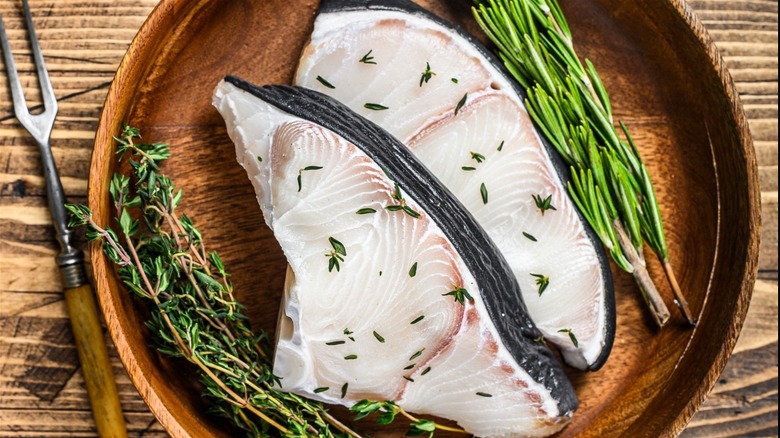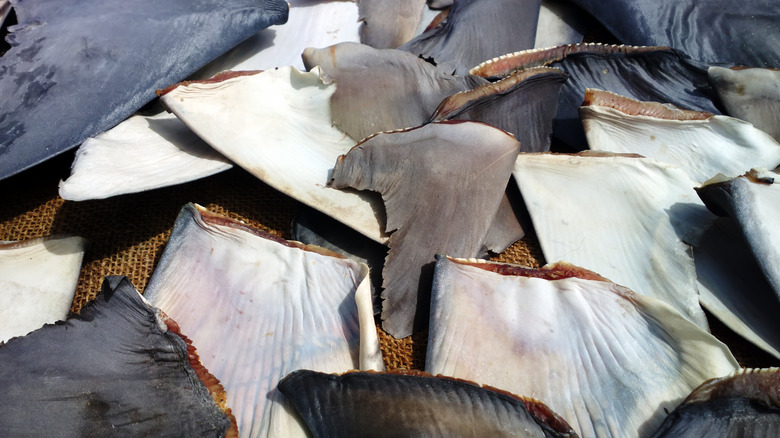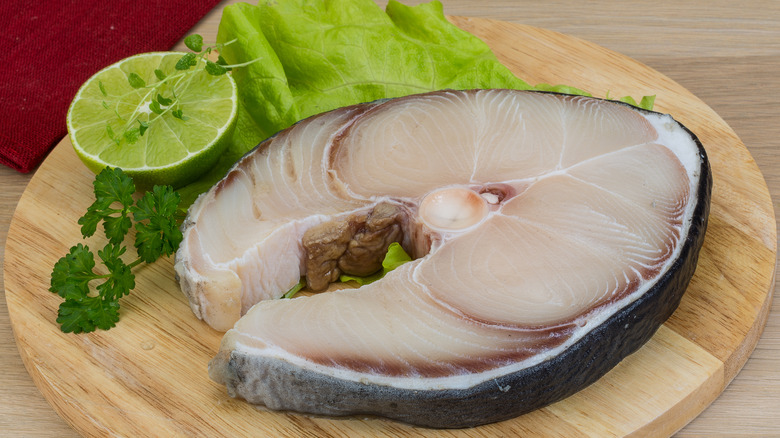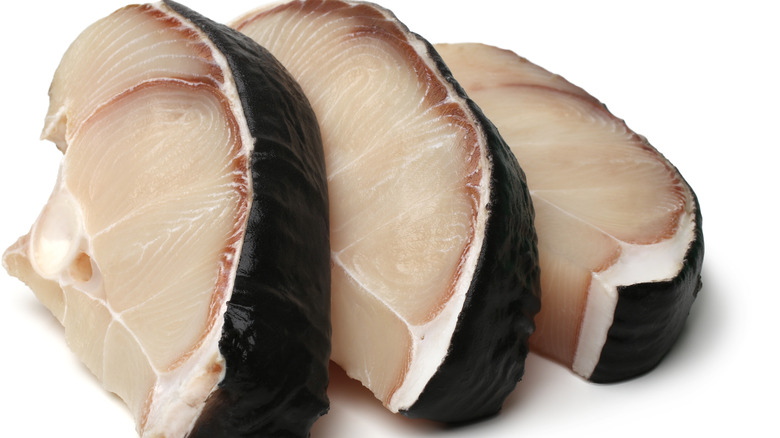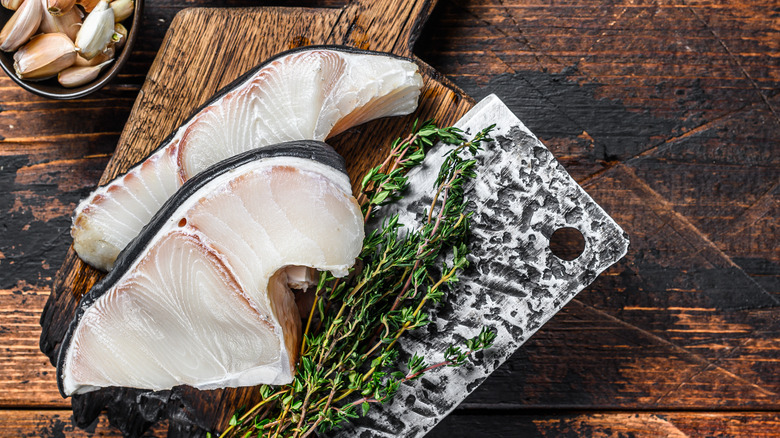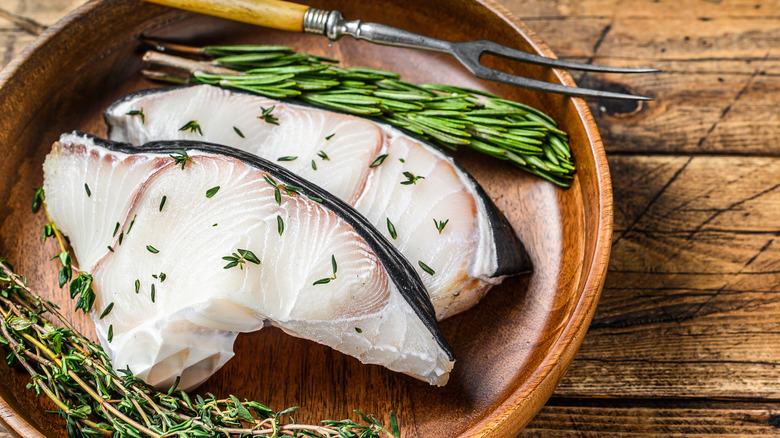What Is Shark Meat And What Does It Taste Like?
"Jaws" popularized the idea of the killer shark, waiting in the ocean to spring on its human prey. But while Shark Week and animal-focused programming might increase our curiosity about these particular creatures, the reality is that sharks are just not another fish in the sea. Indeed, the concept of shark meat being served at the table is growing in popularity.
According to National Oceanic and Atmospheric Administration, shark meat can be a sustainable fish option. As people learn to appreciate sustainable food choices and expand their palates, they learn that fish choices are not just limited to albacore tuna, or the "chicken of the sea." Whether or not the local grocery store or fishmonger will have shark meat remains to be seen. Nevertheless, if you want to try sinking your teeth into that shark filet, we can help you navigate the treacherous waters of this market.
What are some varieties of shark meat?
While there are various species of sharks, only a handful of these varieties are consumed regularly. According to Reel Pursuits, the commonly served shark types are thresher, mako, sevengill, dogfish, soupfin, shovelnose, leopard, and blacktip. Out of that list, the most popular one is usually mako. This type of fish has a dense, heartier texture that has been compared to swordfish. Although the flavor is not exactly the same, shark varieties have a meatier bite versus other white, flaky fish options.
In addition, The Spruce Eats states that shark meat sometimes has other names, including dogfish, flake, grayfish, and whitefish. In addition, imitation crab (surimi) is sometimes shark meat in disguise. Although shark has been used in fish and chips, the firmer fish is often served as a grilled or pan-fried filet. And while there are many varieties of sharks swimming in the ocean, the great white shark from "Jaws" is not likely to appear on the dinner table. In fact, its high mercury levels mean that this would actually be dangerous, per Shark Facts. Still, shark meat can be a delicious addition to the weekly menu.
Shark finning for shark fin soup has dire consequences
Like any conversation about fishing, certain topics can have various layers. For example, the idea of shark finning for shark fin soup is perceived differently than catching sharks for consumption. Considered a Chinese food tradition, shark fin has the distinction of being "one of the eight treasures of Chinese cuisine," per CultureTrip.com. Indeed, it has been served on special occasions, like weddings and celebrations. However, this method — capturing sharks just for the fin and this dish — is now frowned upon.
Per the Shark Fin Sales Elimination Act, possessing, buying, selling, or transporting shark fins is illegal. Eco-Watch reports efforts to eliminate shark finning, as the impact that this process can have on the ecosystem is detrimental. In addition, the potential risk of shark extinction has some people looking to try to redefine the food tradition so that there is not a negative impact on the ecosystem. Some food traditions might be forever tied to culture, but they shouldn't come at the cost of hurting the environment.
While shark finning can be detrimental, it is reportedly different from what U.S. shark fishermen do. According to National Oceanic and Atmospheric Administration, "U.S. shark fishermen work under some of the most robust environmental standards in the world."
Are there concerns about eating shark?
Prepping shark comes with a few more steps than fileting or removing the skin from a fish to ensure that it's ready to be cooked. According to The Spruce Eats, "shark has one of the highest concentrations of mercury of any seafood." Since sharks eat many other fish, they consume large amounts of mercury, which then is passed onto the person who consumes the shark.
As discussed by NDTV Food, eating shark should be done with care. People who have concerns about the high mercury levels should exercise caution, and the fish should be consumed within short order after being caught. While some people believe that shark meat can enhance a person's complexion, the fish might need to come with a warning before going into the pan. Just like the diver uses care in the water, smart handling will make the eating experience more enjoyable.
Sharks are different from other large ocean fish
While various large ocean fish are swimming the waters of Earth, sharks are unlike swordfish and marlin because of the urea in their system. Although this compound helps a shark maintain its metabolic balance, it should not be consumed. As The Spruce Eats describes, the urea transforms into ammonia when a shark dies. For people to consume the shark, the ammonia must be extracted.
With its pungent smell, any cook will want to efficiently remove urea from the shark. Luckily, there are many ways to efficiently do so. The Orlando Sentinel recommends "soaking [the shark] in salt water, vinegar, lime juice, or milk for 30 minutes to two hours. The stronger the odor of ammonia, the longer the shark will need to soak." Elsewhere, Reel Pursuits recommends soaking shark filets in buttermilk for up to 24 hours. We get it: It's tempting to throw that epic fresh catch is right from the boat to the pan. But for the best experience, you'll have to wait a bit until it hits the table.
What does shark meat taste like?
According to USA Today, "shark meat tastes like chicken — or roadkill." Although there is a touch of humor in that statement, it seems to convey that how the fish is prepared is imperative to a tasty flavor experience. As the article continues, there are comments about the "meaty and mild" characteristics of the protein. The texture descriptions include a comparison to alligator or chicken, but not chewy. That statement seems to support the meaty description yet may not completely describe the flavor. Although some people liken any quasi-exotic food to chicken, that comparison can be used any time a food doesn't have a bold or distinctive taste. From absorbing the other ingredients in a recipe to just being non-descriptive, it seems that shark meat on its own is less about the flavor and more about the meaty texture.
How do you cook shark meat?
While there are a variety of sharks that can be eaten, the Orlando Sentinel recommends some general guidance regarding cooking shark meat. The biggest takeaway is to avoid overcooking the fish. According to the outlet, an overcooked shark is tough. Indeed, it seems like any time you overcook a protein, the result is an unpleasant eating experience. In some ways, the dining experience might feel as if the fish is fighting back.
In addition, the publication recommends cooking shark "10 minutes per inch of thickness." This general cooking rule tends to apply to all types of fish. Although the publication does not necessarily specify the level of heat or method of cooking, the options vary. From stew and grilled kebabs to fish and chips, a variety of recipes are available for shark steaks. While personal flavor preferences may vary, good cooking techniques seem to be the most important ingredient.
While the lark of man-eating shark might have started the food conversation, a delicious meal served on the plate will bring people back long after the novelty fades.
